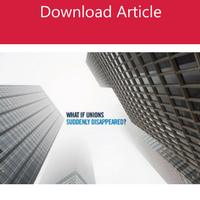U.S. trade union membership was at its peak in the 1950s, when nearly one in three workers were union members.1 Today only one in nine belongs to a union, according to the latest data from the Bureau of Labor Statistics; and the figure is only one in 15 among private-sector workers.2 This decline raises stark questions not only about the challenges that unions face, but also about how the economic landscape might change if labor union membership diminishes further. Indeed, what if unions disappeared altogether?
Read thsi EIU article, sponsored by Prudential >>







